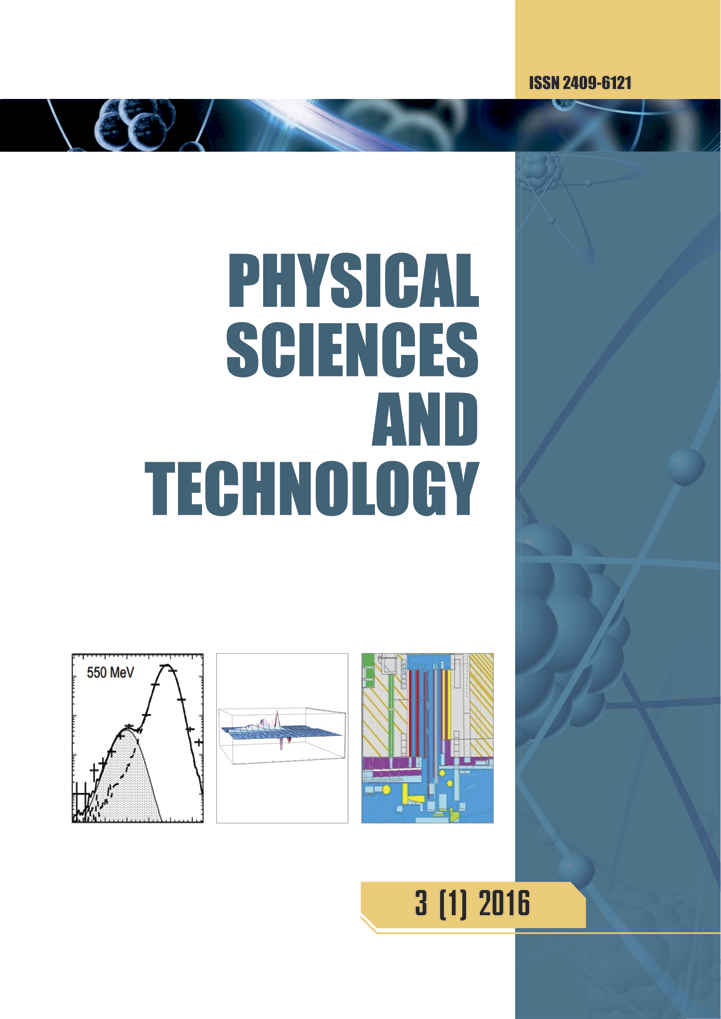Forced reverse reactions in neutron star matter
DOI:
https://doi.org/10.26577/phst-2016-1-92Keywords:
Neutron star, nonlinear interactions, neutron resonances with few-nuclei, electron capture reactionsAbstract
Nuclear reactions in neutron star envelopes are considered in the frame of complex interactions stimulated by huge pressures in the overdense crystalline structures in the envelopes. It leads to the inclusion of forced reverse reactions that transform the nuclei to neutron-rich states and the appearance of free neutrons. The free neutrons in the structures cause resonance interactions with nuclei that fixed in nodes of crystal. The neutron re-scattering on subsystem of few nucleus at the energy near the energy of resonance level of the nucleus creates the few-body resonances, which depend on the distances between the nuclei.
References
[2] Zeldovitch. Yakov. and Igor Novikov. Relati-vistic Astrophysics. V1: Stars and Relativity //New York: Dover Publications. – 1996.
[3] Haensel. Pawel. Potekhin. Alexander Y. and Dmitrii G. Yakovlev. Neutron Stars // New York: Springer. – 2007.
[4] Chamel. Nicolas. and Pawel Haensel. Physics of Neutron Star Crusts // Living Reviews in Relativity. – Vol. 11:10. –2008.
[5] Kirzhnits. David A. On the internal structure of neutron stars //Journal of Experimental and Theoretical Physics. – Vol. 38:503–509. –1960.
[6] Volodin. Vladimir. and David A. Kirzhnits. Influence of crystal lattice on the nuclear properties of superdense matter // Journal of Experimental and Theoretical Physics Letter. – 1971. – Vol.13:450. – P. 52.
[7] Takibayev. N. Neutron Resonance States in Overdense Crystals// Few–Body Systems. – 2013. – Vol. 54:447. – P. 450.
[8] Takibayev. N. Kato. Kiyoshi. and D. Nasirova. Excited Nuclei in Neutron Star Crusts // Advanced Studies in Theoretical Physics. –2013. – Vol.7. – P. 151.
[9] Nucleus Ground State Parameters//Moscow State University. http://cdfe.sinp.msu.ru/
[10] Nuclear Wallet Cards. USA National Nuclear Data Center – NNDC. URL:http://www.nndc.bnl.gov/wallet/wccurrent.html.
[11] Ajzenberg–Selone. Fay. Energy levels of light nuclei A = 5–10 // Nuclear Physics A. – 1988. – Vol.490:1. – P. 169.
[12] Mughabghab. Said F. Atlas of Neutron Resonances// London. New York: Elsevier. –2006.
[13] Ganeev. Rashid A. Higher harmonic generation for intense laser radiation in plasma created by a prepulse acting on the surface of a solid target // Physics–Uspekhi (Advances in Physical Sciences). –2009. – Vol. 179:65. – P.90.
[14] Seres. Enikoe. Seres. Jozsef. and Spielmann. Christian. X–ray absorption spectroscopy in keV range with laser generated high harmonic radiation// Applied Physics Letters. – 2006. – Vol. 89:181919. – P. 181927.
[15] Midorikawa. Katsumi. High–Order Harmonic Generation and Attosecond Science // Japanese Journal of Applied Physics. – 2011. – Vol. 50. – doi:10.1143/JJAP.50.090001.
[16] L'Huilljer. Anne. Schafer. Kenneth J.. and Kenneth C. Kulander. Theoretical aspects of intense field harmonic generation // Journal of Physics B: Atomic. Molecular and Optical Physics. – 1991. – Vol. 24. – P. 3315–3341. doi:10.1088/0953–4075/24/15/004.
[17] Schafer. Kenneth J.. and Kenneth C.. Kulander. High Harmonic Generation from Ultrafast Pump Lasers //Physical Review Letters. – 1997. – Vol. 78. – P. 638. doi:10.1103/physrevlett.78.638.
[18] Takibayev. N. Class of Model Problems in Three–Body Quantum Mechanics That Admit Exact Solutions // Physics of Atomic Nuclei. – 2008. – Vol. 71. – P. 460.
[19] Takibayev. N. Exact Analytical Solutions in Three–Body Problems and Model of Neutrino Generator // EPJ Web of Conferences. – 2010. – Vol. 3. – P. 05028. doi:10.1051/epjconf/20100305028.




